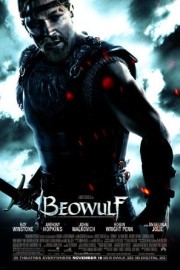Beowulf
Confession: I don’t remember a lick of the famous Old English epic poem- a staple in high school English classes- that was the basis for Robert Zemeckis’ latest experiment in ground-breaking motion capture computer animation, building on the relative success of his 2004 children’s fable “The Polar Express” (a true cinematic experience, if a little too “for the kids” for this adult to merit multiple viewings) and the popularity of recent action fantasy epics like “Lord of the Rings” and “300” to create something that truly feels like nothing else we’ve seen before. Probably for the best that I don’t really remember the source material- the film is intended to stand on its’ own without Cliff Notes, although I was suddenly curious to dig up my old copy of it to reread it.
The story is simple enough anyway (at least in the film)- a small village is continually tormented by Grendel the monster (Crispin Glover, providing vocals and movements to haunting effect). The old King (Anthony Hopkins, providing both the vocal and physical inspiration for the character) sends out a call for a hero to vanquish the monster. Enter Beowulf (voiced by Ray Winstone, though the physical model was not based on him), whose exploits are famous throughout the land. He dispatches of Grendel, but a price comes with his victory that extends to his own rein as King.
Zemeckis directs the script by fantasy author Neil Gaiman (“Stardust”) and “Pulp Fiction” co-author Roger Avery with an energy and excitement we typically don’t associate with the “Forrest Gump” Oscar winner. But his box-office success over the years makes one forget just how audacious of a filmmaker he is. He stranded Tom Hanks on an island for over an hour in “Cast Away.” He debated science vs. religion in “Contact.” He used visual effects to put his main character into historical situations in “Gump.” He blended live-action and animation with “Who Framed Roger Rabbit?” He even toyed with the comic possibilities of incest in “Back to the Future.” Now he’s at the forefront of cutting-edge digital filmmaking with his last two films, and while the digital humans are still a bit stiff to look at, the technology has improved dramatically since digital life-like humans made their debut in “Final Fantasy: The Spirits Within.” Also benefitting “Beowulf” is the digital 3-D process I saw the film in (I missed “Polar” in 3-D), which makes the action come alive with a depth we’re unaccustomed to in this type of movie. The action sequence between Beowulf and Grendel in particular (which even includes a nod to the nudity hiding of “Austin Powers” and “Eyes Wide Shut” in its’ attempt at the PG-13 rating) trumps the action scenes in the visually impressive- but dramatically void- “300.”
Unlike that smash, however, “Beowulf” has a dramatic core that is as compelling as its’ visual splendor. Gaiman and Avery’s screenplay doesn’t rate high on the logic level, but thematically they turn an archetypal heroes’ quest into a morality tale about the mythology of a hero, and the shades of grey that go with building a legend. The King’s right hand (a sneering John Malkovich) senses it immediately, and the King’s Queen (Robin Wright Penn)- later Beowulf’s Queen as well- begins to sense something’s up also. Grendel’s mother (a seductive Angelina Jolie) holds the key to Beowulf’s secrets…in more ways than one.
The film’s thematic strength is just one of the surprises Zemeckis has in store. Like his hero, he relishes in creating a myth around his story with flourishes that extend the story’s penache (in the film’s case, the breathtaking visuals and Alan Silvestri’s bombastic score, coupled with songs in collaboration with “Polar” songwriter Glen Ballard) and believability. The surface of “Beowulf” visually is a little too artificial to completely succeed, but Zemeckis tells a riveting tale to get lost in. I can’t speak for regular viewing, but in 3-D, you won’t be able to take your eyes off of it.










